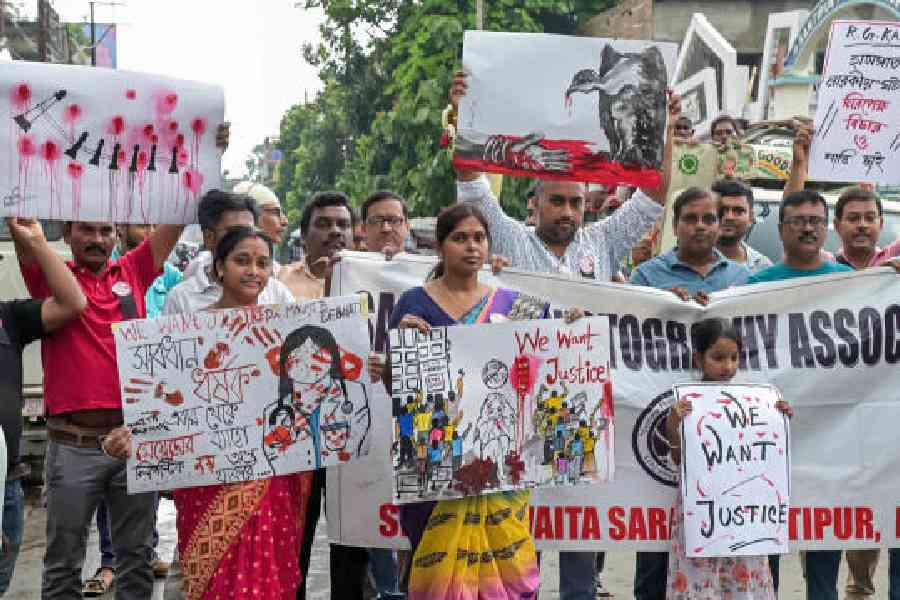The last two weeks of roil in Bengal could be an indication that the state’s most popular extant leader by far has misplaced her finger on the public pulse.
The developments across Bengal over the past 10 days — since the junior doctor’s rape and murder at RG Kar Medical College and Hospital — have hit the teflon image of Mamata Banerjee who probably faces the biggest political challenge of her life as the demand for justice for the victim has snowballed into a call for her resignation.
The Supreme Court has taken suo motu cognisance of the incident and the case will come up for hearing on Tuesday.
The demand for her resignation has gained traction not only in urban areas but also in remote corners of Bengal.
There is little doubt that social media manoeuvring by the BJP and other Opposition parties have contributed to making the incident a national issue. But one cannot ignore the fact that the rage witnessed across the state was spontaneous. A litany of erroneous steps by the state administration has created an unprecedented situation for Mamata.
Soon after the 31-year-old doctor had been murdered, the chief minister called up the parents of the victim, principally agreed to a CBI probe, visited their home and concurred with the general demand for capital punishment for the guilty.
The government’s overall response matrix, however, included several avoidable steps.
First and foremost was the appointment of Sandip Ghosh, the former principal of RG Kar, at another government medical facility, which gave an impression that the state’s top brass was trying to shield a discredited man.
Calcutta police, which had handled the probe before the high court handed it over to the CBI, compounded Mamata’s problems when commissioner Vineet Goyal initially refused to admit that Sanjoy Roy, the prime accused, was a civic volunteer. It created a perception that the police brass was trying to hide something.
A decision by the authorities to renovate portions of the emergency building’s third floor, where the doctor was raped and murdered, triggered an uproar as people felt that there were attempts to destroy vital evidence.
The spontaneous movement against the crime crystallised on the night of August 14 when tens of thousands of women, and men, hit the streets. While people across Bengal united to express collective rage, unidentified persons barged into the premises of RG Kar hospital and vandalised portions of the facility. The police did little to prevent the vandals.
A lot of the anger over the doctor’s murder and the vandalism was targeted at Mamata, who handles the health and home portfolios.
Even as the litany of erroneous steps kept adding fuel to the protest fire, a seemingly rattled administration scored an own goal by cancelling the Mohun Bagan-East Bengal derby scheduled for Sunday when the city witnessed unprecedented scenes with supporters of the bitter rivals joining the chorus, demanding her resignation.
The decision by the city police to summon prominent doctors like Kunal Sarkar and Subarna Goswami for social media posts ended up further antagonising the medical fraternity, which is already up in arms against the government.
In this hour of crisis, the odds seem heavily stacked against the chief minister as discordant voices can be heard even from within the ruling Trinamul Congress. The problem is not limited to the public outburst of Rajya Sabha member Sukhendu Shekhar Roy, who created a flutter on Sunday with his social media post demanding custodial interrogation of Ghosh and Goyal. Lower-level functionaries of the TMC were seen joining the agitations demanding justice.
The all-India general secretary of Trinamool, Abhishek Banerjee, is reportedly upset with the administration’s response to the crisis and has decided not to be involved in countering the narrative against the government. The TMC’s lacklustre response to the social media assault — largely by the saffron ecosystem — on Mamata has
been attributed to Abhishek’s invisibility.
Although the situation changed on Sunday night with the TMC beginning to counter the social media onslaught, the damage has already been done to the ruling party.
The last three decades of Bengal politics witnessed several instances of Mamata scoring over her detractors — be it the Singur movement that earned her an anti-industry tag or the 2016 Assembly elections in which she led the scam-tainted party against a united Opposition of the CPM and the Congress.
Will the teflon pass the RG Kar test?
Only time will tell.










